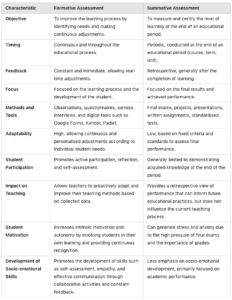Imagine a science class where the teacher does not wait until the end of the semester to know if their students have understood the water cycle. Instead, they use quick questions during the lesson, observe the answers, and adapt their teaching in real-time to address immediate doubts and confusions. The teacher is applying formative assessment, a pedagogical tool that transforms every moment of the class into an opportunity for learning and continuous improvement for both the student and the teacher.
Formative assessment goes far beyond conducting exams or tests that produce results to determine how much a student knows. It is a dynamic approach that places the student at the center of the educational process, allowing personalized adjustments that foster deeper and more meaningful learning. Constant and detailed feedback is the fundamental element of formative assessment, helping students understand their learning processes and develop critical skills that extend beyond the classroom.
In this article, we will explore what formative assessment is and the transformative impact it can have on education.
Formative assessment goes far beyond conducting exams or tests that produce results to determine how much a student knows. It is a dynamic approach that places the student at the center of the educational process, allowing personalized adjustments that foster deeper and more meaningful learning.
What is Formative Assessment?
Formative assessment is a structured process that involves the collection and analysis of evidence to make informed judgments about student progress, identify areas for improvement, and provide feedback. Its primary purpose is to enhance student learning. Additionally, it offers teachers the opportunity to reflect on their educational practice and adjust their teaching strategies and activities according to the students’ needs.
Formative assessment is characterized by several distinctive qualities that set it apart from other types of assessments, such as summative assessments. Here are some of the most relevant characteristics:
- Continuity and Progressiveness: Formative assessment is conducted continuously throughout the teaching-learning process. It is not limited to specific moments but is an ongoing process aimed at monitoring and improving student learning as it progresses.
- Immediate and Continuous Feedback: It provides students with frequent and detailed comments on their performance. This feedback helps them understand their mistakes and successes, facilitating the correction of strategies and the consolidation of knowledge.
- Focus on the Learning Process: Rather than on the final results, formative assessment focuses on the process students follow to achieve their learning goals. This includes observing the skills, attitudes, and strategies used by students during their learning.
- Personalization and Adaptation: It allows teaching strategies to be adjusted according to the individual needs of students. Teachers can identify the areas where each student needs more support and adapt their methods accordingly.
- Motivation and Autonomy: By encouraging active student participation in their own learning, formative assessment increases intrinsic motivation and autonomy. Students become more aware of their progress and are more engaged in their learning.
- Use of Diverse Tools: It includes a variety of methods and tools for gathering information, such as observations, questionnaires, surveys, interviews, and digital tools like Google Forms, Kahoot, and Padlet, which facilitate interactive and real-time assessment.
- Development of Socio-Emotional Skills: Besides academic aspects, formative assessment also focuses on developing socio-emotional skills, such as self-assessment, empathy, and effective communication, promoting the integral development of the student.
Formative Assessment vs. Summative Assessment
In recent years, there has been a development in formative assessment in response to the need for a more student-centered educational approach, supported by technological advances, research on its effectiveness, favorable educational policies, and the diversification of student needs.
Summative assessment, the classic final exams that caused us so much stress and anxiety at the end of the school term, remains an important element of the learning process. However, its role must be reevaluated and contextualized within a broader framework that includes both formative and summative assessments. Assessment expert Paul Black explains it this way: “When the cook tastes the soup, that’s formative assessment. When the diner tastes the soup, that’s summative assessment.”
Here, we compare both assessments.

Challenges of Formative Assessment
Despite its numerous benefits, formative assessment faces some implementation challenges. Some of the main challenges include:
- Workload for Teachers: Implementing formative assessment continuously requires significant time and effort from teachers. Preparing, administering, and analyzing formative assessments, as well as providing individualized feedback, can considerably increase teachers’ workload.
- Teacher Training and Professional Development: Not all teachers are adequately trained in formative assessment techniques and strategies. Continuous training is needed to ensure that teachers understand how to use these assessments effectively and how to interpret the data obtained to improve teaching.
- Limited Resources: The lack of material and technological resources can hinder the implementation of formative assessment. Without access to adequate tools, such as assessment software and digital devices, conducting formative assessments efficiently and effectively is more challenging.
- Resistance to Change: Some teachers and administrators may resist changing from traditional assessment methods to formative approaches. This resistance can be due to a lack of familiarity, fear of change, or doubts about the effectiveness of new methodologies.
- Inequalities in Access: Students from different socioeconomic backgrounds may not have the same access to the tools needed to fully participate in formative assessment. This can create inequalities in the quality and quantity of feedback they receive.
- Data Management: Collecting, analyzing, and using formative assessment data requires data management skills. Teachers must be able to correctly interpret the information to make informed instructional decisions.
- Student Motivation and Engagement: Keeping students motivated and engaged with formative assessment can be challenging. Some students may not see the immediate value of these assessments and therefore may not actively participate.
Implementing formative assessment offers multiple benefits. It allows teachers to reflect on their pedagogical practices and adjust their teaching to improve learning processes and student performance. Moreover, it actively involves students in their learning journey, allowing them to track their progress and set personalized learning goals.
Promoting formative assessment is essential for developing students’ motivation and self-regulation. Through deliberate and constant interaction with students about their learning process, teachers can foster a more effective and student-centered educational environment. For these reasons, it is crucial to encourage its implementation at all educational levels, ensuring that both teachers and students can fully benefit from its advantages.






